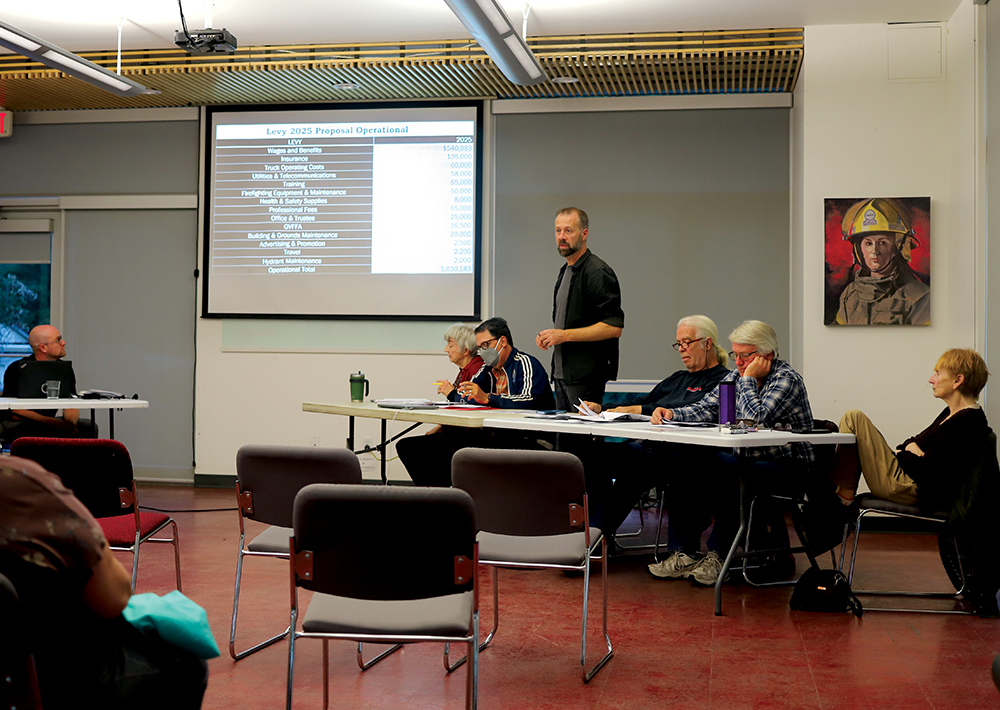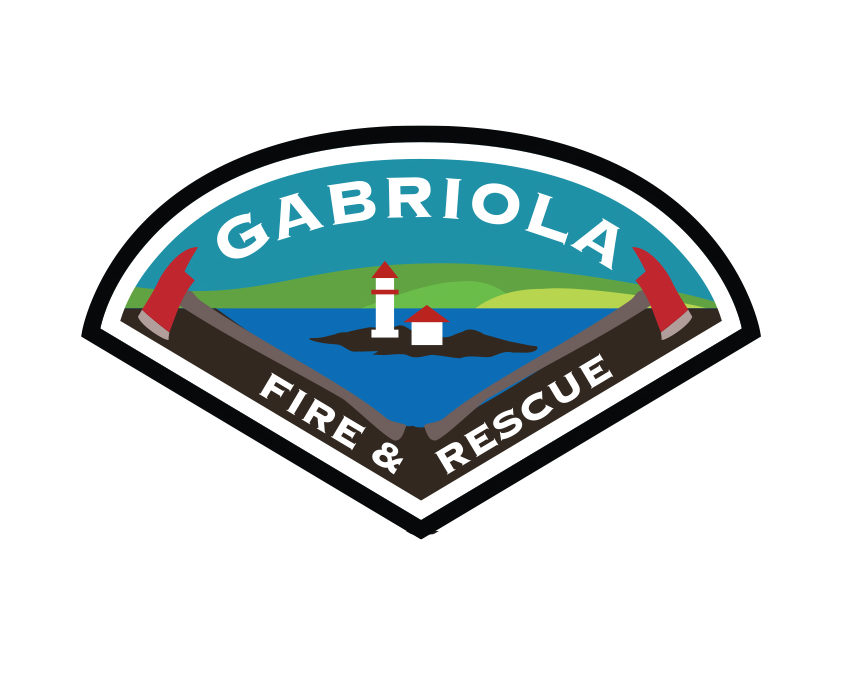Derek Kilbourn
Sounder News
The Gabriola Fire Protection Improvement District Board has released the draft of its Long Term Plan for the Gabriola Volunteer Fire Department – with the 2025 budget and levy being the start of putting that plan into action.
The Board held a special meeting last Wednesday, September 18 at the Albert Reed Memorial Fire Hall #1 on Church Street.
Attended by approximately 40 people, the meeting saw presentations from Trustee Charlene Wells, Trustee John Moeller, and Corporate Officer Matt Dow.
Wells spearheaded the Long Term Plan project, while Moeller as chair of the Financial Subcommittee presented on the 2025 budget, which will start the 10-year long-term financial plan.
As reported in last week’s Sounder, the proposed levy increase for 2025 will be 38% (more accurately, 37.5%).
In his presentation, Dow explained the financial impact of this increase, saying that his numbers were an estimation, as the District does not know what the Municipal Tax Rate will be in 2025. He said a property that was assessed at $500,000 in 2024 would have roughly paid $240 dollars. If the levy goes ahead as proposed, with a 38% increase would be an additional $90 dollars for that household.
Moeller explained that the plan is to have a higher increase for 2025, and then with each year through the ten-year plan, to lower the annual increase. 2026 will see a 14.17% increase; 2027 a 10.48% increase, and so on until 2029 when annual increases are being kept under 7%.
The operations budget itself will increase 28.22% in 2025, from $803,458 to $1,030,183. The capital budget will increase 71.35% from $213,000 to $369,840.
This increase in capital reflects the District’s need to have monies set aside for those capital expenditures, rather than borrowing monies to purchase trucks, or pulling from operational funding for SCBA equipment.
The contribution to the Capital Reserve for trucks will go from $80,000 in 2024 to $200,000 in 2025, increasing by roughly $20,000 a year.
The Board was asked, given the increases seen in truck costs – a million dollar truck is expected to cost $1.5 million next year – could the plan actually be falling short on anticipating future purchase prices?
Moeller said, “I hope not, but this is a living document. It does have to get reviewed annually.”
Chair Paul Giffin said this long range plan is being introduced with the Levy.
“This plan goes to 2034. Next year we’ll be discussing a long range plan that goes to 2036, with the 2026 levy. What I’m hopeful for is as we move forward, those numbers get adjusted, and I’m hoping to get it adjusted down.
“It’s crazy right now. So this, what we’ve done here is a first step, and hopefully subsequent wards will do the same – look at the 10 year plan every time they look at the levy and adjust course.”

Fire Trustee John Moeller, as chair of the Finance Subcommittee, goes through the proposed 2025 Fire District budget. Derek Kilbourn photo
Dow’s presentation focused in on the changes coming for the 2025 Levy.
As he explained, the biggest increases are being seen in Professional Fees (171%), Building and Grounds Maintenance (100%), Health and Safety Supplies (60%), and Truck Operating Costs (48%).
In 2024, the District budgeted Truck Operating Costs to be $40,500. The forecast, according to Dow, is for that to increase to around $53,000 by year-end.
Given this, the District is budgeting $60,000 for 2025 for truck operations.
Part of this is due to increasing fuel costs, but the other factor is as the trucks age, they have need more frequent minor maintenance.
He used the example of one truck needing new tires, which came to $10,000 after taxes and additional fees.
While Grounds Maintenance is relatively small due to the Day Firefighters handling that, the Building Maintenance are the regular small repairs being done in all three Halls, which Dow says has added up, pushing the Maintenance budget from $10,000 to $20,000.
The largest percentage increase in the budget is Professional Fees.
Dow said, “over the last two years, Professionals Fees has gone way over our previous budget estimates. Therefore, we have had to take money from the Fire Department’s Operations.
“We believe Legal Services will cost roughly $10,000 next year, Privacy Works $30,000, KMA [Accountant] $15,000, and there is an additional $10,000 as a buffer. We strongly hope we will not need the entire $65,000 and can start forecasting lower amounts.”
In his presentation, Dow compared the mill rates, call volumes, populations, and wages of the Gabriola department to other gulf islands, as well as North Cedar, saying Cedar is of comparable geographical and population size to Gabriola.
Gabriola’s mill rate in 2024 was 0.48. According to Dow, the median mill rate for fire protection in the gulf islands is 0.64.
Departments that was compared to were North Cedar (0.55), South Galiano (0.60), Denman (0.61), Hornby (0.69), Pender (0.71), Salt Spring (0.80), and North Galiano (0.82).
Of those communities, only Salt Spring had a higher number of properties; and a higher population. It is also the only Department with more calls than Gabriola. Dow showed Salt Spring had 735 callouts in 2023, compared to Gabriola with 562; North Cedar with 476; Pender with 290; Hornby with 187; and Denman with 102.
Dialing into just Pender, North Cedar, and Salt Spring to Gabriola, Dow showed how the Levy has increased for the four Fire Districts since 2014. Gabriola’s has shifted from approx $600,000 in 2014 to just over $800,000 in 2023 – while North Cedar has gone from $1,000,000 in 20214 to $1.4 million in 2023. Salt Spring increased from $2.4 million to $4.6 million in the same time period. Pender data started at 2017, and increased from $800,000 to just over $1,000,000 in 2023.
Dow compared the current salaries of the Gabriola Fire Chief ($80,000) and Deputy Fire Chief ($75,000) to the average for rural departments in BC ($119,000 and $103,000 respectively).
Dow said, “I would also like to stress that most Fire Chief and Deputy Fire Chief’s in other Improvement Districts and/or small rural municipalities only work 40 hours a week. They usually get additional pay for being on call. Our hope will get both the Fire Chief and Deputy Fire Chief to meet these rural Provincial averages by 2027.”
He also showed that on average, the hourly wages for the Gabriola firefighters are $2 to $5 lower per hour (depending on rank and qualifications) than the average for their peers in non-unionized departments.
To make up for this, starting in 2025, there will be a $3 an hour increase for all ranks from Captain to Candidate.
Dow said the hope is to get the entire membership to meet provincial averages by 2027.
Speaking to the increases to the Capital reserves, Dow said a new Tender will be needed in 2035, a new Engine 3 in 2038, and Engine 1 in 2040.
These needs are coupled with the creation of a new Capital Replacement for Equipment reserve. Dow said the current Annual Capital Replacement cannot keep up with the limited lifespan of crucial firefighting equipment.
“Moreover, all our SCBAs are going to expire in 2034 and will cost roughly $400,000 dollars.”
Dow said the Fire Hall Repair and Replacement Fund was started with the 2024 levy. “This fund, unlike the Grounds & Building Maintenance will be primarily used to replace Hall capital (e.g. hot water tank) as well as substantial size repairs.”
During the public Question and Answer period of the meeting, Wayne Mercier asked the Board if it would commit to putting in a bylaw committing capital reserve funds to those specific items that the taxes are being collected for.
Chair Paul Giffin said no, that the Ministry of Municipal Affairs had said there is no requirement for a bylaw for such.
Giffin said that were such a bylaw put in place for specific capital reserve expenditures, “the only way the money can be spent is for what is covered in the bylaw, so you are tying that money up.”
Giffin added, “every year, the department and improvement district is audited. So there is an accounting of where every penny goes. That audit is presented at the AGM [Annual General Meeting] in April.”
Speaking after the meeting, Mercier said his concern with the lack of a bylaw to secure the capital funding, this means the District could use the money for whatever purpose it decides, even though it is collecting tax money with the premise they will use it for a particular purpose.
Mercier said, “hundreds of thousands – millions – of dollars in money collected from taxes against future need should not be susceptible to the whims of a changeable board. Nothing compels the board to protect those funds by bylaw, but they should do it, because it is the proper thing to do, and shows a commitment to their expressed plans and purposes.”
Mercier later commented saying the overall long range plan and presentation was great, in particular, “the detail and amount of attention that has gone into planning for capacity for the Fire Department to respond to emergencies.”
He added, “in looking at the long range plan, not a lot of attention [was] paid to the governance role of the Improvement District.
“What steps, if any, are being contemplated for the governance shortfalls – for instance, formalization of agreements of Mallet Creek dam. It’s hard as a land owner to understand what’s going on, if things are being done in the back rooms. Do you have a plan to address those?” Giffin asked what that question had to do with the Long Range Plan and Levy. Mercier said, “there wasn’t much attention paid to the role of Trustees. “The only long range plan for the Trustees was to support the department in the long range plan. I’m wondering what long range plans you have, if any, for governance and oversight?”





Recent Comments